
Amazon Sales Ranking and Author Rank
- Amazon Sales Rank
- Book Contract Negotiation
- Cover Design and Page Layout
- Print On Demand Cost and Profit
- Industry Book Sales
- SciFi eBook Publishing
- Query Letters and Book Proposals
- Indexing a Book in Word
- Order Book
Copyright 2016 by Morris Rosenthal
All Rights Reserved
Calculate How Many Books Amazon Sells from Ranks
Note: This analysis is in no way sponsored or approved by Amazon.com. And a quick note for those authors whose sales ranks don't appear to agree with their reported sales. You have to keep in mind that Amazon sales rank included sales of both new and used books from Marketplace sellers, who ship more than one in three items sold by through Amazon. I've added a new section about the new Amazon Author ranks lower on the page.
The following graph is based on January, February and March data from last year, I'll update it when the ranking system settles out again, but the situation hasn't changed much because paper book sales are steady if not declining. The graph addresses books with an average Amazon sales rank between 1,000 and 1,000,000. Actual sales vary with day, week and season (think Christmas), and the January/February data period includes Spring semester textbook sales. Amazon's textbook sales grow every year, so they have increasing impact on the rankings during textbook season, causing non-textbook sales to look poor by comparison.The sales equivalencies for lower ranks (ie, bigger rank number getting into the millions) mean little in terms of average sales unless you can average them over years. I cannot stress enough that for any sales rank, checking the rank on Amazon twice and looking at this graph means nothing. You have to get an average rank for at least a week on stronger sellers for it to have any meaning at all. Amazon's overall share of industry book sales has grown so much in recent years that the bestsellers are disappearing from the main graph! Amazon has sold more than 7.5 million unique titles at this point, and rankings indicate a title must sell at least one copy a year to remain above a rank of two million.
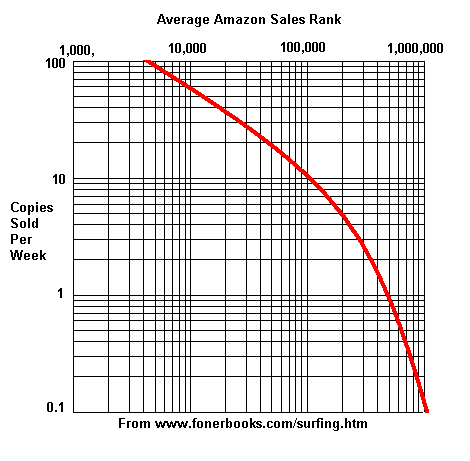
The very top ranks graph is a rough estimate from a couple summers ago when Amazon was displaying stocking data for books on the product pages.
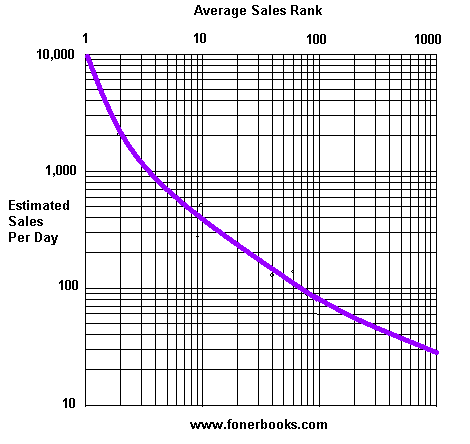
If you like the videos, check out my publishing channel. Note that I didn't use estimated data for a sales rank of 1, I just rank it out to 10,000 a day, since it's going to be all over the place, depending on the particular date and bestseller.
The best option for tracking both ranks and actual sales for most authors is Amazon's Author Central. Author Central not only give the complete historical sales rank data for as long as the book has been tracked (you have to claim it as yours first), it also provides Nielsen Bookscan data for the whole country, which includes most bookstore sales. The graph below shows two years of historical sales rank data from Author Central for one of my titles. The extra deep drops at the end of last summer were caused by Amazon dropping 24 hour stocking of popular titles printed by Lightning Source. When I shifted the title to Amazon CreateSpace, sales largely recovered.
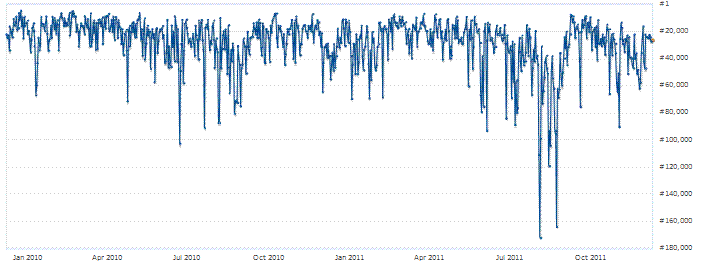
For those authors don't want to visit Amazon all the time, you can use salesrankexpress.com to check all of your books at once and also get historical ranking information once you sign up for it.
I used to include a table giving some equivalent sales numbers for some distinct ranks, but I dropped it with the recent update. Nobody outside of Amazon knows EXACTLY how many copies of a given title are sold in a given time period, and since ranks are relative to each other, it's a constantly moving target. The idea behind my reverse-engineering the ranking system was always to give rough idea of how a title was selling, not an exact number. So, don't read an average rank of 10,000 to mean you sold exactly 60 books that week, or a rank of 100,000 to mean you sold ten and a half copies - Amazon doesn't sell half copies. Read an average rank of 1,000 to mean you have a seriously successful title, an average rank of 10,000 to mean your doing pretty good for a book that's no bestseller, an average rank of 100,000 to mean it's not going to contribute significantly to your income, and an average rank of 1,000,000 to mean you need to take a break from checking sales ranks.
Two books about selling on Amazon that everybody should take a look at. The first is Steve Weber's "The Home Based Bookstore", which describes in detail the art of selling through Amazon Marketplace. The second is Aaron Shepard's "Aiming at Amazon" a publishing business plan that focuses on Amazon sales. Finally, if you're interested in the publishing system I use to make my living, and for which I've walked away from many trade contract offers, I summed it all up in "Print-on-Demand Book Publishing", not to be confused with subsidy publishing.
Several parties have written academic papers based my earlier sales rank analysis and linking this page. I used to keep copies on this site, but I realized that they are all in the Internet Archive as far back as 2001.
Amazon Author Ranks
Amazon introduced Author Ranks on October 10, 2012, with two weeks of trailing data. The idea is very similar to sales ranks, it's simply ranks authors by total sales of paper books or Kindle eBooks each day within the Amazon system. The initial data in my own Author Central account showed my author sales rank for books:
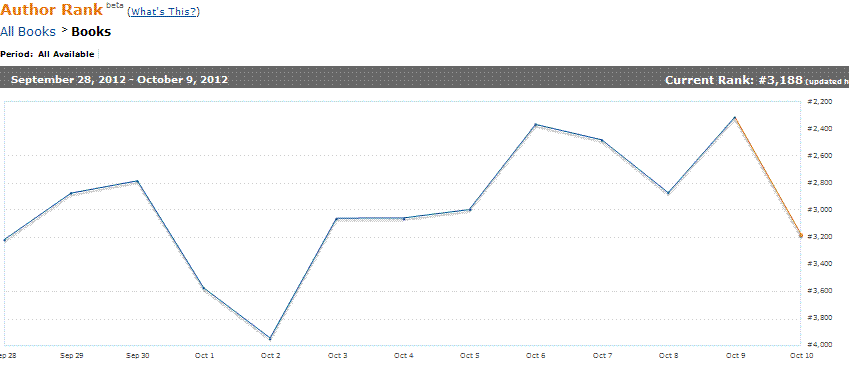
and my author sales rank for Kindle:
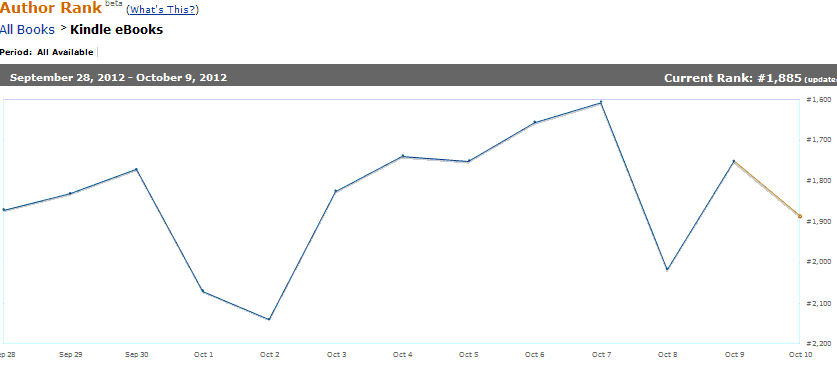
I make my average author rank on paper to be around 3,000 for the two weeks, while my average author rank on Kindle is around 1,900. Given the author rankings and the number of books and Kindle eBooks the author is selling, I could work out a pretty good graph of the overall Amazon ecosystem for making a living as an author. ANybody who wants to participate in confidentiality is welcome to contact me with their rank and sales data.